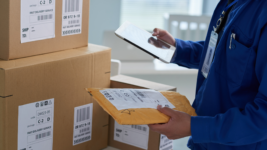If you’re looking for reasons to be thankful this November, you might want to steer clear of the latest UPS news.
In late October, the carrier announced its General Rate Increases for 2022, and let’s just say trying to digest them is antacid worthy.
Among other things, UPS plans to raise prices on its Ground, Air, and International Services by an average of 5.9%. It’s also implementing a 1% increase for Domestic Fuel Surcharges and increasing rates for more than 70 other surcharges.
Here at AFS, we’re anything but surprised about this announcement – or its uncanny resemblance to FedEx’s earlier one. However, that doesn’t mean we’re cavalier about it, which is why we’d like to pass along the following “Cliff’s Notes” advice about what the new charges could mean for our clients and their bottom lines.
When will these newly announced changes go into effect?
It depends. Some changes like the extra 1% Fuel Surcharge, started as early as November 15, while others, like the base rate increase, will become effective December 26. The latest new charge – the Remote Area Surcharge – will go into effect January 9.
What will happen to base rates for Ground, Air, and International services?
Like FedEx’s 2022 base rates, these will increase by an average of 5.9%.
UPS’s premium service customers will take the biggest hit, especially customers who use Next-Day Air (up an average of 7.3% across shorter zones) and those who ship via 3-Day Select (up anywhere from 9.2% – 9.9% across all zones).
What about the Ground minimum?
That’s changing from $8.76 per package to $9.36 per package (an increase of 6.9%), exactly like FedEx’s.
And yes, in case you haven’t noticed, the minimum charge increase is actually higher than the announced average base rate increase. That’s why we always advise our clients to pursue discounts for both the minimum charge and the base rate.
How will the Residential Surcharge be impacted?
During non-peak times, this will become $4.85 for Ground (a 9.0% increase) and $5.35 for Air (a 7.0% increase).
What’s happening with UPS’s Additional Handling and Oversize Surcharges?
On average, UPS’s Additional Handling Surcharges will increase anywhere from 5.2% – 13.9%. Specifically, these charges will become:
- $15.75 to $20.50 for dimensional (5.0% -14.0% more than this year’s charge of $15.00 – $18.00)
- $25.25 to $30.50 for weight (5.2% – 13.0% more than this year’s charge of $24.00 – $27.00)
- And $14.00 to $17.50 for packaging (6.7% less for zone 2 shippers, the same for zones 3 and 4 shippers, and 6.1% more for zones 5 and higher than this year’s charge of $14.00 – $16.00).
Large Package Surcharges will increase by an average of anywhere from 8.0% – 16.7%.
- Commercial delivery customers will pay a Large Package Surcharge of anywhere from $110.00 – $140.00 per package (up 10.0% – 16.7% from this year’s charge of $100.00 – $120.00).
- Residential delivery customers will pay a Large Package Surcharge of anywhere from $135.00 – $165.00 per package (up 8.0% – $13.9% from this year’s charge of $125.00 – $145.00).
How will Peak Surcharges be impacted?
They’re also going up.
- The Additional Handling Peak Surcharge of $6.00 per package will be $2.50 more (71% higher) than the same charge for last year’s holiday season, while the Oversize Peak Surcharge of $60.00 per package will be $20.00 more (50% higher) than the same charge during last year’s holiday season.
- Peak Residential Delivery Surcharges for high-volume shippers (those who ship an average of 25,000 packages each week) will also continue to apply. This year, those charges will be anywhere from 5%-72% higher.
In other news, UPS is rebranding its Peak Surcharges. These will now be known as Peak/Demand Surcharges. While UPS didn’t expressly state its reason for doing so, the word on the street is that this probably means that Peak Surcharges may become permanent, year-round realities instead of just holiday traditions.
Are there any other new – or newly modified – surcharges?
UPS is introducing a Remote Area Surcharge (RAS) and moving 2,692 ZIP codes that were formerly subject to its DAS Extended Surcharge under this umbrella. Each RAS package will be assessed a $12.00 per package charge, which represents a 103% increase over the previous DAS Extended Surcharge of $5.90 that it is replacing.
Meanwhile, DAS or DAS Extended packages will be charged anywhere from $0.30 – $0.60 more, a 9.2% – 10.2% increase.
Where can you go to learn more?
It’s never fun trying to decipher the ins and outs of any carrier’s new rates and surcharges, especially when they’re not designed to be crystal-clear. So, if you’d like a more detailed analysis – or advice about how to mitigate the effect of UPS’s 2022 GRI on your business – send us an e-mail at [email protected]. Our veteran parcel experts and analysts look forward to helping you minimize your shipping expenses while optimizing your efficiency.
Or, tune into our webinar to hear AFS president of parcel, Scott Lord, drill into the UPS 2022 GRI numbers and learn how they could affect your budgets.




